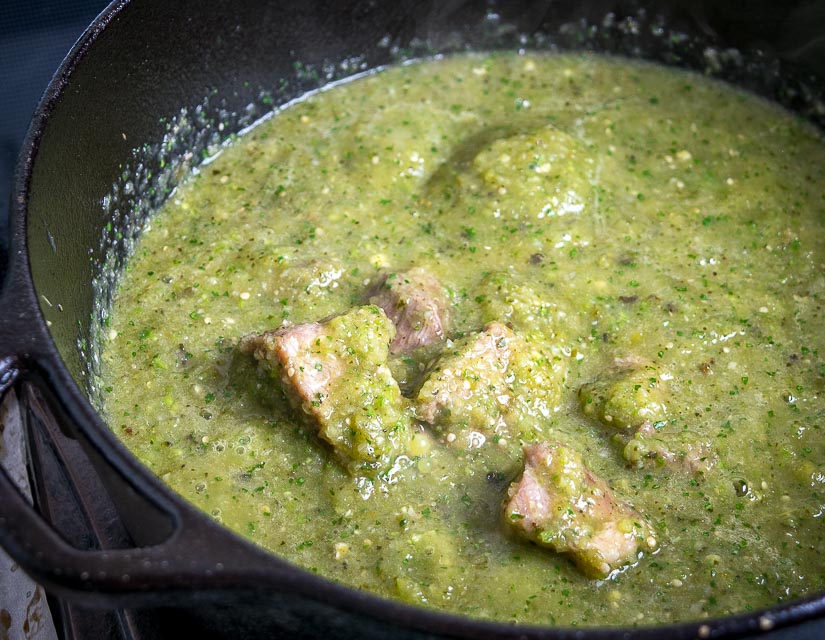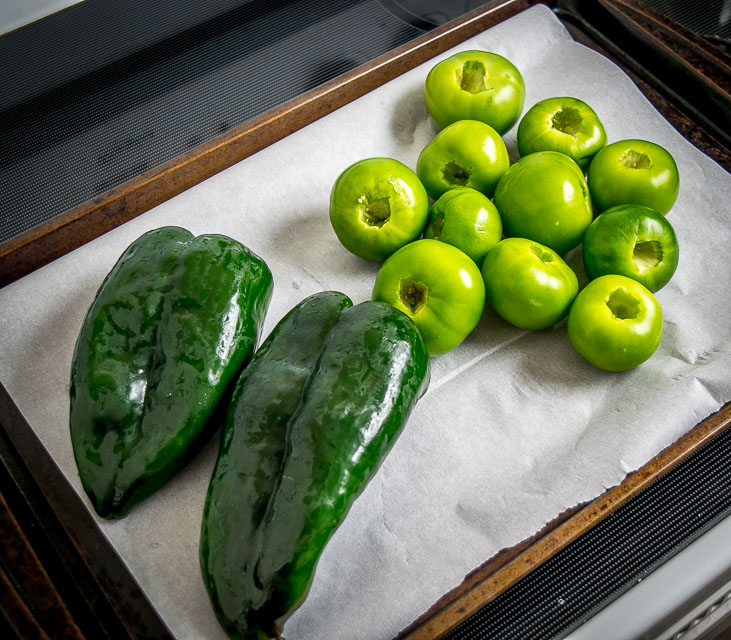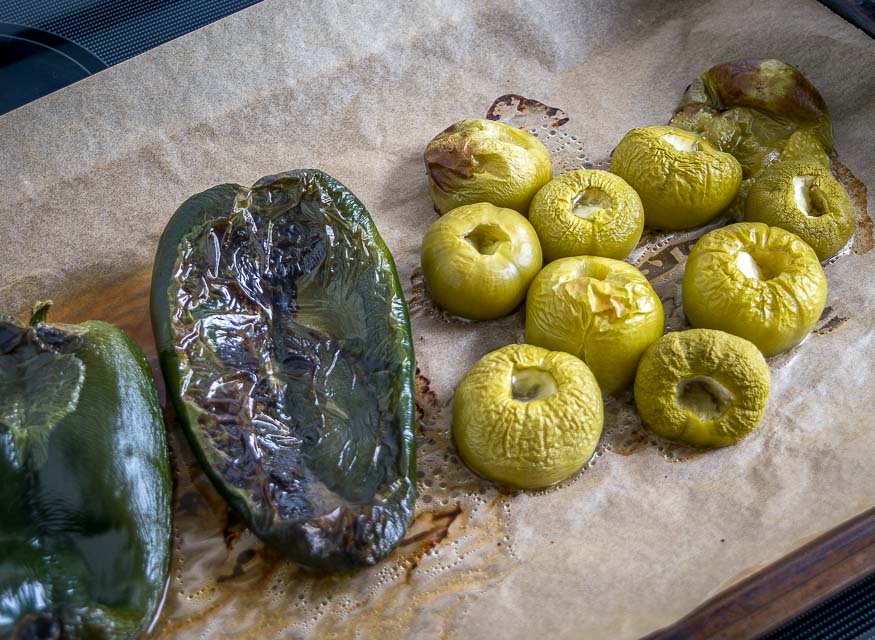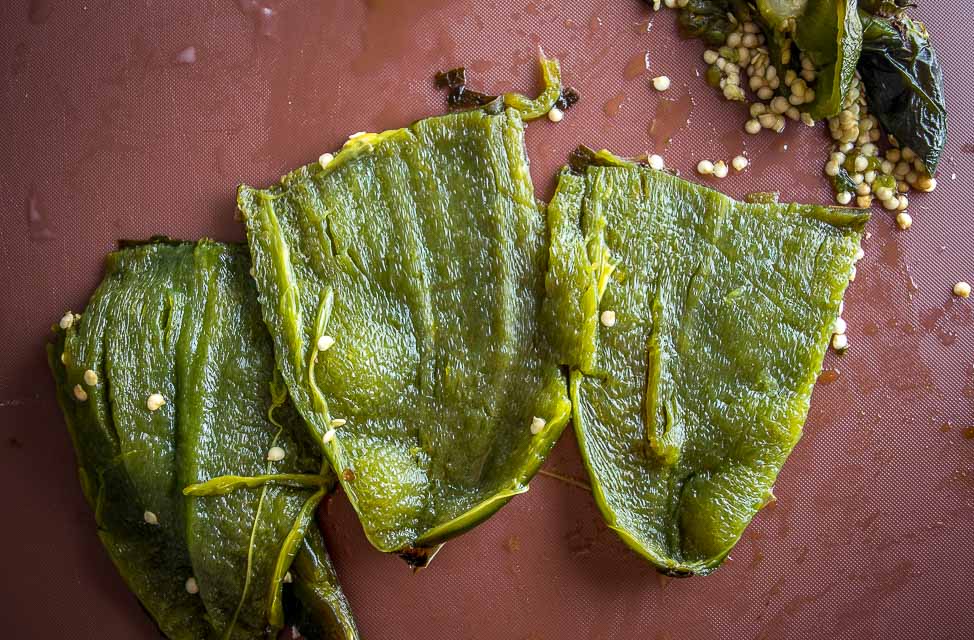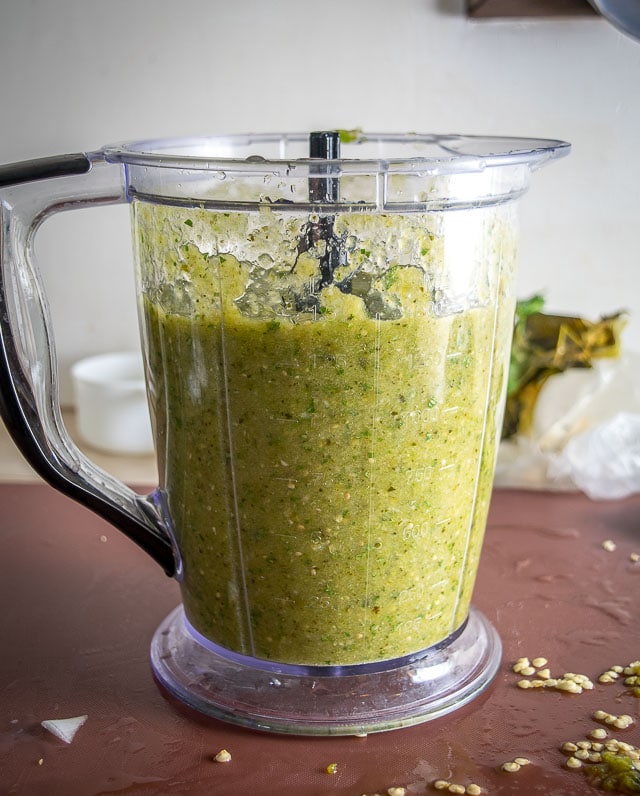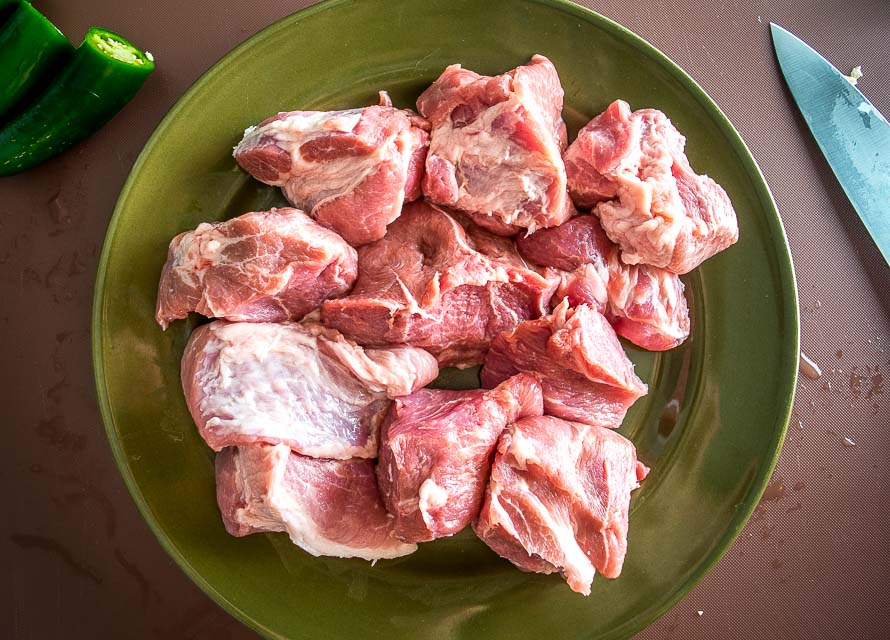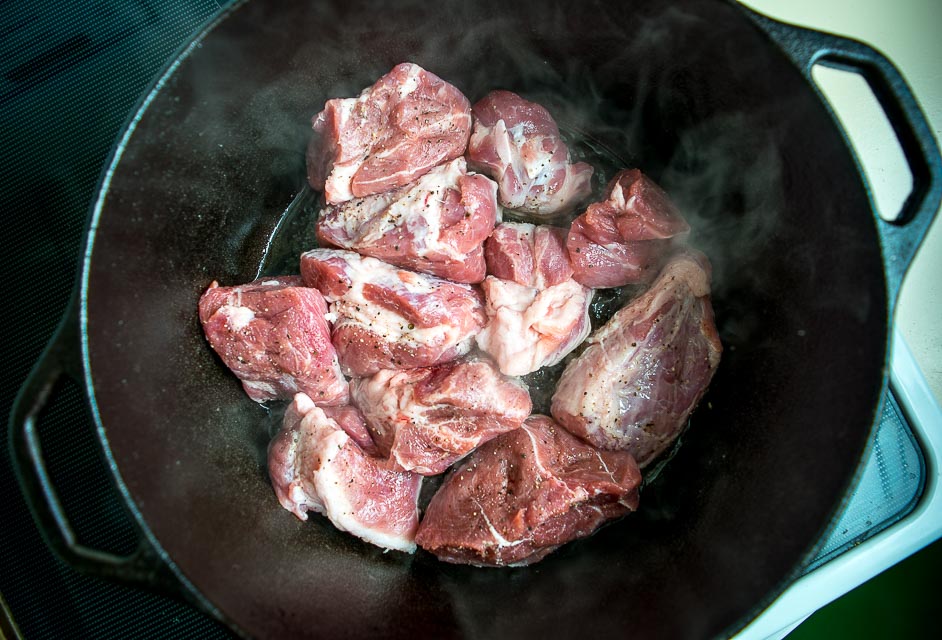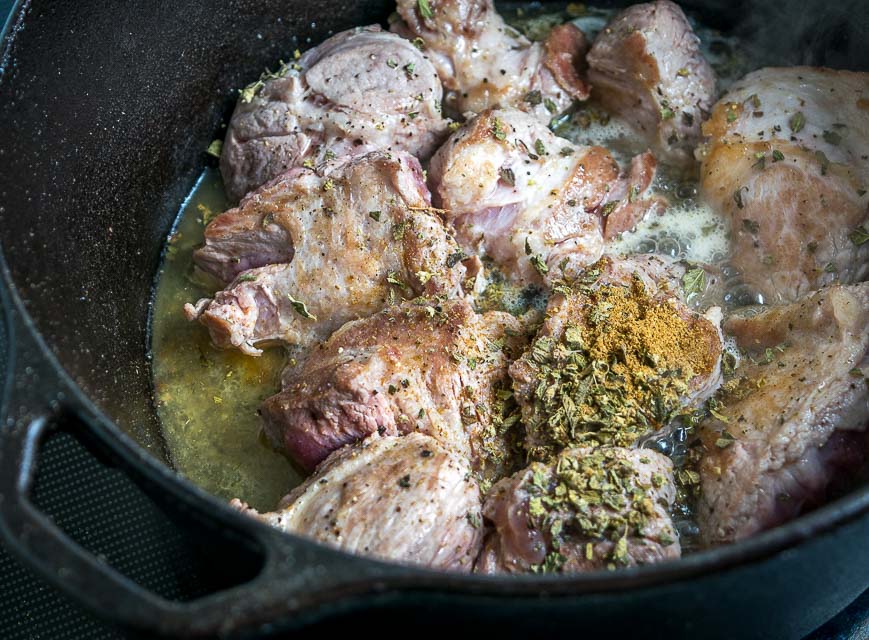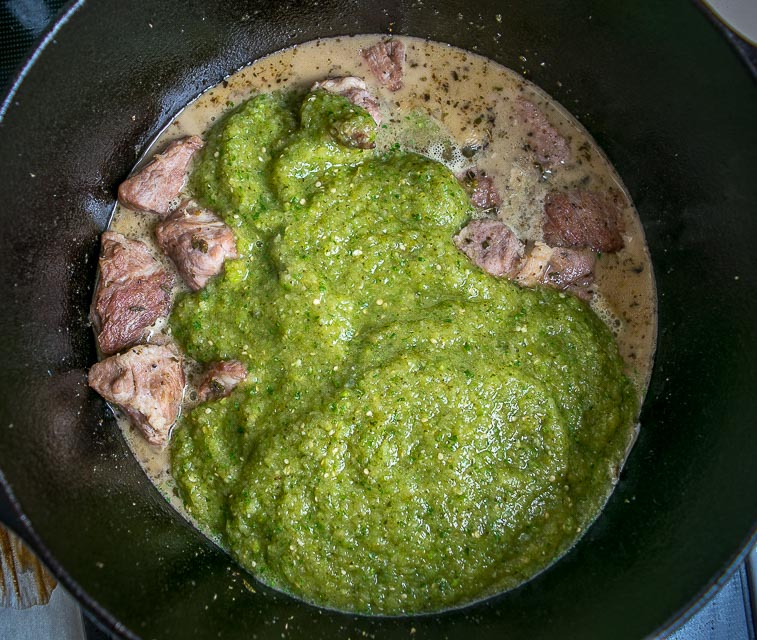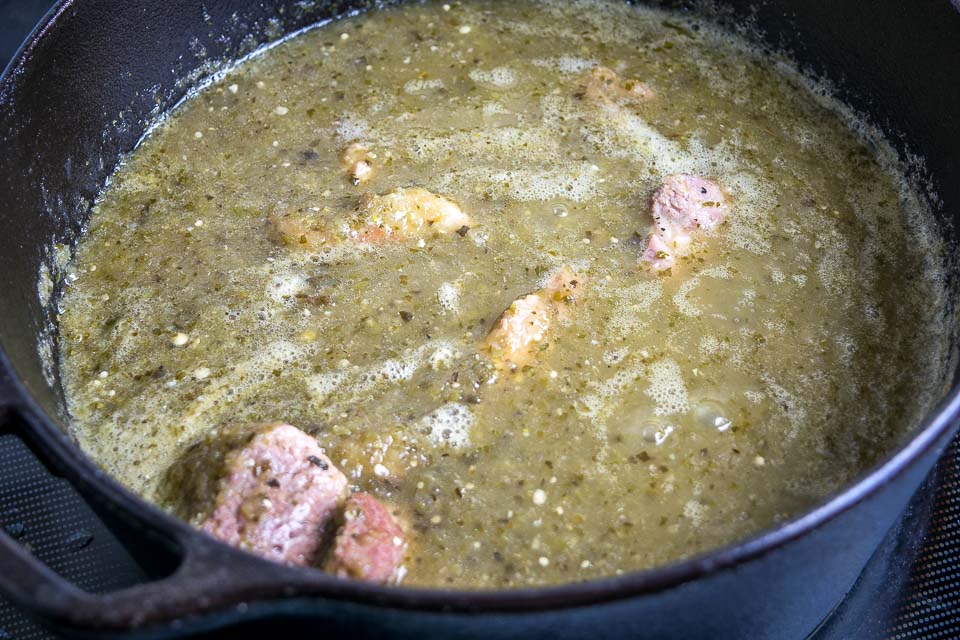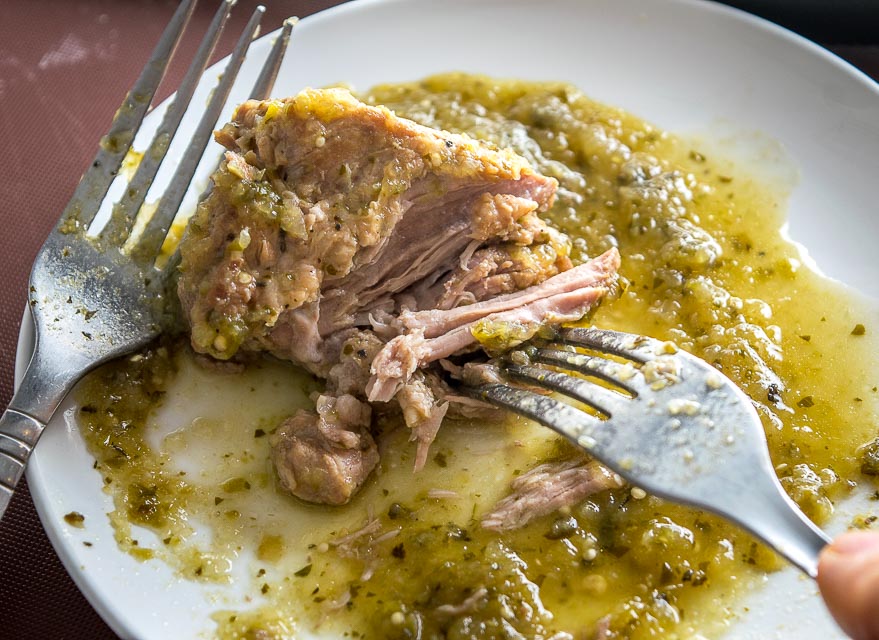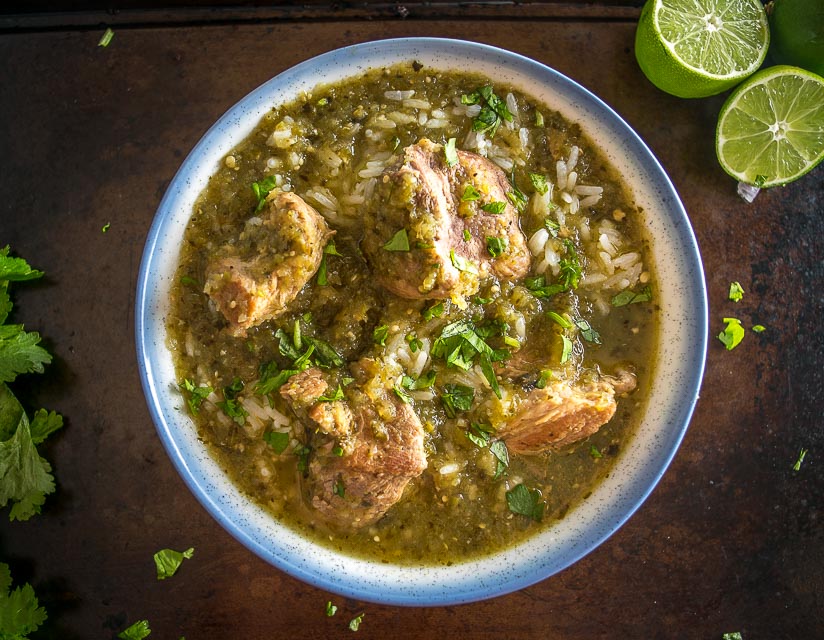Chili Verde is a worthy ambassador for all of Mexican cuisine. It has a comforting, otherworldly flavor that people respond to with a Yup, there it is -- as if they are rediscovering a long lost flavor that's been missing for a few generations.
While it's traditionally served as a stew, the great thing about Chili Verde is that you can use it for all sorts of on-the-fly meals. Make a bigger batch and you'll be eating Chili Verde burritos and quesadillas for the rest of the week.
Sound good?
Chili Verde is most commonly served with pork, but keep in mind that you've got some leeway on the protein choice as the luscious green sauce is by far the more important element. I'll put up some vegetarian and beef options at some point, but for this version we're using pork shoulder and this is the perfect starting point if you're new to Chili Verde.
You'll frequently see pork shoulder sold in 2 - 2.5 lb. chunks and that's a good size for this recipe. It's an inexpensive cut of meat that responds well to low-and-slow cooking. If you give it enough time it will remind you how the phrase fork tender came into existence.
And while you'll frequently see pork shoulder used in the slow cooker (as in our Slow Cooker Carnitas), an equally good option is a leisurely stove simmer so that's what we'll do for this batch.
But before you start browning the meat, it's best to get the poblanos and tomatillos roasting as these are the key building blocks for the green sauce.
I think it's easiest to just plop these in a 400F oven. If you're in a rush you can get to the finish line quicker by using the broiler, but I usually just put them in the oven and start working on the other ingredients.
I'm also in the habit of cutting out the tomatillo stems knowing that any juice leftover on the roasting pan will go into the blender as well. And yes, you can also roast the jalapenos and onion, but as with our Salsas I tend to add those in raw.
In a half hour the poblanos and tomatillos will look like this:
I usually flip the poblanos after 15-20 minutes, and if the tomatillos are disintegrating at that point you can take them off the roasting pan as they don't need as much time in the oven as the poblanos.
See all the wrinkled bits of skin on the poblanos? Once they cool down you can pull off and discard as much of that skin as possible.
An additional step would be to put the poblanos in a sealed Ziploc to loosen up the remaining skin, but I usually skip this step when the poblanos are headed to the blender as any leftover skin won't affect the flavor. When making a dish like Rajas I am more likely to remove all of the skin as it can affect the texture when the poblanos are served in strips.
You can also de-stem and de-seed the poblanos once they cool off.
Add the poblanos to a blender along with:
the roasted tomatillos (and any leftover juices)
3 de-stemmed jalapenos
2 peeled onions
4 peeled garlic cloves
1/2 bunch rinsed cilantro
I usually just twist off and discard the bottom, thicker portions of the cilantro but use the upper stems that hold the leaves together.
And note that you might have to blend a portion of it first to get everything to fit into a single blender, but eventually you'll end up with a blender full of green Chili Verde goodness.
Even without any seasoning there is some serious flavor in this blender. Give it a taste and you'll get a quick preview of the core Chili Verde flavor!
And yes, using three jalapenos will create some serious zip! If you want a milder version you can always dial back on the jalapenos.
Okay, that's the green sauce in a nutshell and once you get the poblanos and tomatillos roasting in the oven you can start working on the pork.
I know it's tempting to remove most of the fat, but the chunks that simmer with some fat attached will usually be the most tender pieces!
So I cut the pork into 1.5-2" chunks and leave plenty of the fat knowing that it can always be trimmed off after the simmer. Season well with salt and pepper.
Warm up a thin layer of oil in a Dutch oven or saucepan over medium-high heat. Add the pork chunks and form a single layer as much as you can.
Brown both sides of the pork, approximately 3-4 minutes per side. I find it easiest to use tongs to flip over the individual pieces. You can do this in batches if your pan isn't wide enough.
Once browned, you can drain off any excess fat but it will depend on the cut of meat you're using. I didn't drain off any fat for this batch.
We'll now add:
1 cup chicken stock
1/2 teaspoon salt
freshly cracked black pepper
1 tablespoon Mexican oregano
1/4 teaspoon cumin (optional)
I'm a huge fan of Mexican oregano in this dish so I think it's worth sourcing some out if you're new to it. It won't make or break the dish, but I do think it complements the roasted poblano flavor quite well. I would probably just omit it before adding regular oregano. (What's the Difference Between Regular and Mexican Oregano?)
The stock will quickly come to a boil and this is perfect as it will deglaze the pan. Stir well and scrape up any bits of fond that are stuck to the pot -- this will add additional flavor to the sauce.
Add the green sauce from the blender along with another cup of stock and combine well. I usually rinse out the blender with the final cup of stock so that you get all the leftover green bits.
Bring to a boil and then reduce heat to a very quiet simmer (medium-low for my stove). This is going to cook low and slow, anywhere from 2-3 hours.
I usually cover the pot so that it retains most of the liquid.
I should also mention that I make this dish extra saucy -- you'll have loads of the green sauce and the pork pieces will be having a comfortable adult swim as they simmer away.
The ample green sauce will give you tons of options for leftovers. You can build meals around it so I like to have plenty of it on hand when I make a batch.
Here's what this batch looked like after simmering away for two hours:
Yes, you're going to lose some of that vibrant green color, but you're going to gain so much more!
I usually start checking the pork for tenderness after two hours. It's done when it nearly pulls apart on its own.
If it's still tough then give it some more time on the stove. The heat will eventually break down the fatty connective strands and give you some tender, moist pieces. This batch simmered for about 2 1/2 hours.
If you follow the recipe you should have plenty of liquid in the pot for the simmer, but if it ever looks low to you then you can always add additional stock.
Once you're happy with the tenderness of the pork then it's time to take a final taste for seasoning! I added generous pinches of salt and Mexican oregano at this point, but keep in mind that this will depend on which stock you're using.
If it's your first time making Chili Verde I recommend serving it over some white rice to see how your palate reacts. The sauce has so much flavor that you really don't need much else and I eat it like this quite often.
In other words, serve some rice and pork with your green sauce, and not the other way around!
Taste good?
And maybe familiar?
Chili Verde is such a great dish to add to your repertoire so I hope it treats you well. Once you're comfortable making the sauce I think you'll find all sorts of ways to use it.
Click 'Next Recipe' down below to continue.

Chile Verde
Ingredients
- 2-2.5 lbs. pork shoulder
- 2 cups chicken stock
- 4 cups cooked rice
- 1 tablespoon Mexican oregano
- 1/4 teaspoon cumin (optional)
- oil
- 1/2 teaspoon salt (plus more to taste)
- freshly cracked black pepper
- cilantro for garnish (optional)
- lime for garnish (optional)
For the Green Sauce:
- 10 tomatillos (approx. 1 lb.)
- 3 jalapenos
- 2 white onions
- 3 poblanos (or 2 larger ones)
- 4 garlic cloves
- 1/2 bunch cilantro
Instructions
- Pull off the husks of the tomatillos and give them a good rinse. I usually de-stem them but this is optional. Add the tomatillos to a roasting pan along with the rinsed poblanos and roast them in the oven at 400F. I usually flip the poblanos over after 15-20 minutes, and if the tomatillos are disintegrating you can take them out of the oven at this point. The poblanos will need about 30 minutes total to fully roast.
- Once the poblanos and tomatillos are in the oven I usually start working on the meat, but here are the remaining green sauce instructions that you can do while the meat is browning:
- Add the remaining green sauce ingredients to a blender: 2 peeled onions, 3 de-stemmed jalapenos, 4 peeled garlic cloves, and 1/2 bunch of rinsed cilantro. I usually just twist off and discard the bottom, thicker portions of the cilantro but use the upper stems that hold the leaves together.
- Once the poblanos have fully roasted, remove them from the oven and let them cool down for a few minutes. Pull off and discard as much of the skin as you can. De-stem and de-seed them. I find it easiest to cut off the tops and then make a slit lengthwise. Open up the pepper and use the knife to scrape out the veins and seeds.
- Add the poblanos and tomatillos to the blender and combine well with the other ingredients. You might have to blend half first to get all of it to fit into a single blender.
- Cut the pork shoulder into 1.5-2" chunks. I usually cut off any thick pieces of fat but I do try to leave some fat on each of the chunks. Season well with salt and pepper. Add a thin layer of oil to a Dutch oven or saucepot over medium-high heat. Once the oil is hot add the pork and try to create a single layer so that it browns evenly. You can do it in batches if you have to. Cook until well browned on both sides, approximately 3-4 minutes per side. Once browned, you can drain any fat if you want but I usually leave most of it in.
- Add 1 cup of chicken stock to the pot along with 1/2 teaspoon salt, freshly cracked black pepper, 1 tablespoon Mexican oregano, and 1/4 teaspoon cumin (optional). It will simmer quickly and this gives you a chance to scrape up any bits of fond that are stuck to the pan.
- Add the blended green sauce to the browned pork along with a final cup of stock. I usually add the final cup of stock to the blender and swish it around to get all the leftover green bits.
- Bring the Chile Verde to boil and then reduce heat to a simmer, which was medium-low on my stove. Cover and simmer for 2-3 hours.
- I usually test the pork after 2 hours. If it's tender and pulls apart easily then it's ready to serve. If it's tough then give it some more time on the stove. This batch simmered for about 2 1/2 hours.
- Take a final taste for seasoning. I added generous pinches of salt and Mexican oregano at this point, but keep in mind this will depend on which stock you're using.
- Serve over rice and optionally garnish with freshly chopped cilantro and a squeeze of lime. Be sure to serve plenty of the sauce in each bowl as that's the key to Chile Verde. Buen Provecho!
- Store leftovers in an airtight container in the fridge.
Notes


